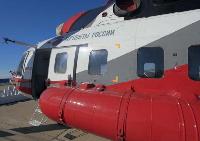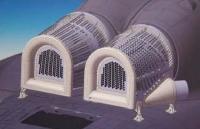Фотографии
-
The Mi-171 A2’s rotor hub and blades were derived from those fitted to the Mi-38.
Самолёты на фотографии: Миль Ми-38 - Россия - 2003Миль Ми-8МТВ-5 / Ми-17В-5 / Ми-8АМТ - Россия - 1995
-
An attractive payload/range capability and a considerable increase in the cruise speed are promised for the Mi-171A2 due to the all-new rotor system and more powerful and fuel-efficient engines.
Самолёты на фотографии: Миль Ми-8МТВ-5 / Ми-17В-5 / Ми-8АМТ - Россия - 1995
-
The X-shaped tail rotor provides better efficiency and produces 20% less noise.
Самолёты на фотографии: Миль Ми-8МТВ-5 / Ми-17В-5 / Ми-8АМТ - Россия - 1995
-
The current production-standard Mi-171A (this one is operated by UTair) is now regarded as an ageing design and Russian commercial operators have raised requirements for a more modern aircraft featuring a rapidly re-configurable cabin and a type certification in accordance to European and US airworthiness requirements.
Самолёты на фотографии: Миль Ми-8МТВ-5 / Ми-17В-5 / Ми-8АМТ - Россия - 1995
-
A forward-facing KOS-17 camera, mounted in the nose of the helicopter, covers a 120° arc in the horizontal plane for enhanced situational awareness.
Самолёты на фотографии: Миль Ми-8МТВ-5 / Ми-17В-5 / Ми-8АМТ - Россия - 1995
-
Only minor cosmetic changes were made from the Mi-171's external layout to reduce development time and costs.
Самолёты на фотографии: Миль Ми-8МТВ-5 / Ми-17В-5 / Ми-8АМТ - Россия - 1995
-
Pall intake filters are intended to provide reliable operation and save the engines from wear and tear in dusty and sandy conditions.
Самолёты на фотографии: Миль Ми-8МТВ-5 / Ми-17В-5 / Ми-8АМТ - Россия - 1995
-
The first prototype Mi-171A2 (OP-1) pictured during its public debut at the MAKS airshow at Zhukovsky near Moscow in August 2013.
Самолёты на фотографии: Миль Ми-8МТВ-5 / Ми-17В-5 / Ми-8АМТ - Россия - 1995
-
Compared to its predecessor, the Mi-171A2’s fuselage structure is almost the same with the only difference being a reinforced floor in order to allow installation of crash-resistant passenger seats.
Самолёты на фотографии: Миль Ми-8МТВ-5 / Ми-17В-5 / Ми-8АМТ - Россия - 1995
-
Four 6x8 in LCD screens show flight/navigation and system information and a central 15 in display provides digital map information or video images derived from the enhanced visibility system.
Самолёты на фотографии: Миль Ми-8МТВ-5 / Ми-17В-5 / Ми-8АМТ - Россия - 1995
-
A computer-generated image of the yet-to-be-developed search and rescue version of the Mi-171A2.
Самолёты на фотографии: Миль Ми-8МТВ-5 / Ми-17В-5 / Ми-8АМТ - Россия - 1995
Статьи
- -
- News
- A.Mladenov - New Trekker /Commercial/
- A.Mladenov - Revitalising a Legend /Paramilitary/
- A.Spaeth - Defending 'Dutchness' /Commercial/
- D.Isby - Networked Intelligence /Military/
- D.Oliver - EC135P3/T3 Generation Three /Commercial/
- G.Warner - To the Rescue /Paramilitary/
- I.Harding, N.Martin - Merlin MK2 Advances /Military/
- J.Lake - Ringing in the Changes /Commercial/
- M.Broadbent - The Swiss Bizjet /Commercial/
- N.Beckett - Lifting the Veil /Technology/
- N.Pittaway - A350 XWB World Tour /Commercial/
- N.Pittaway - Australian SAR /Paramilitary/
- P.Butowski - New Eyes for an Old Coot /Military/
- R.Dorr - B-2 Spirit. Stealth Bomber at a Crossroads /Military/
- S.Bennett - Safety an Innovation a Zero-sum Game? /Commercial/
- S.Degraef, E.Borremans - Border Force /Paramilitary/










